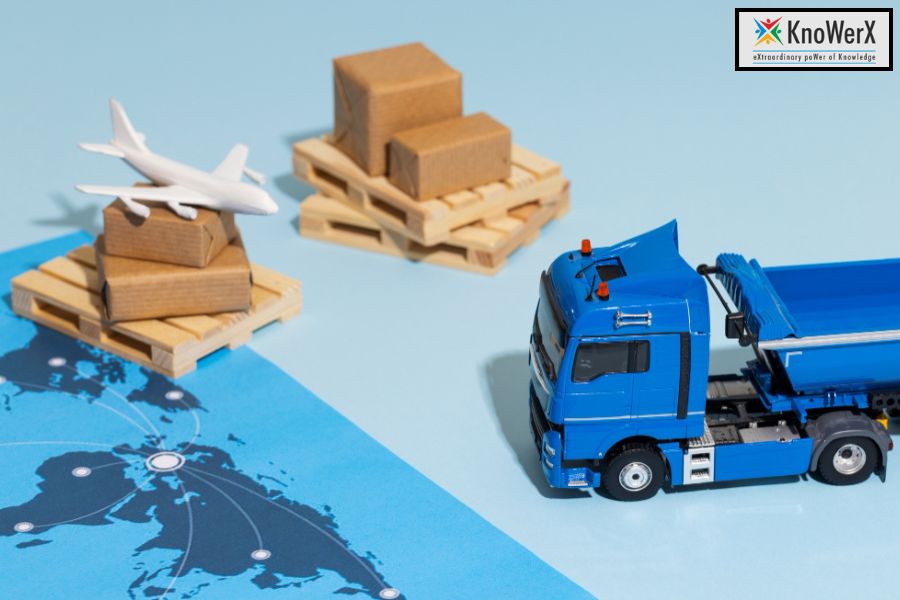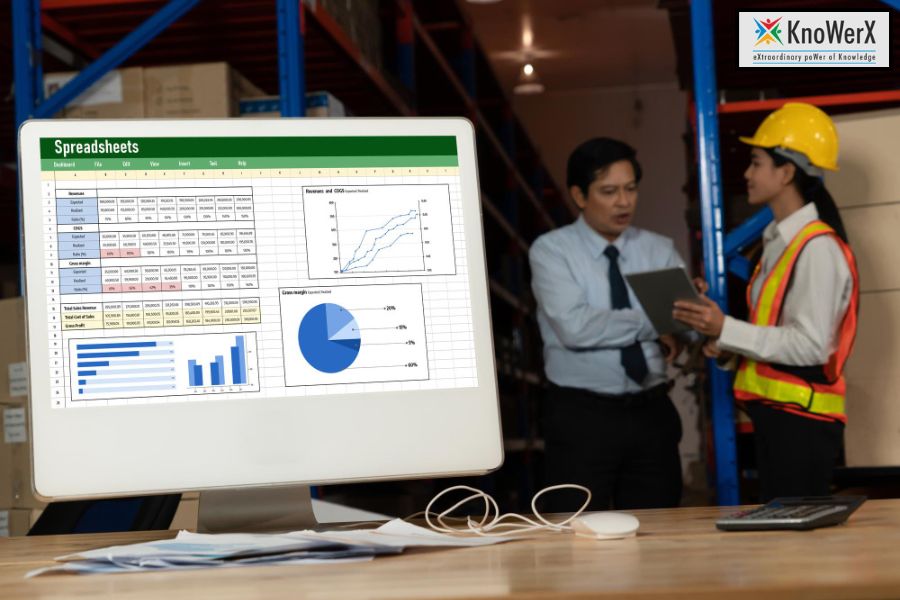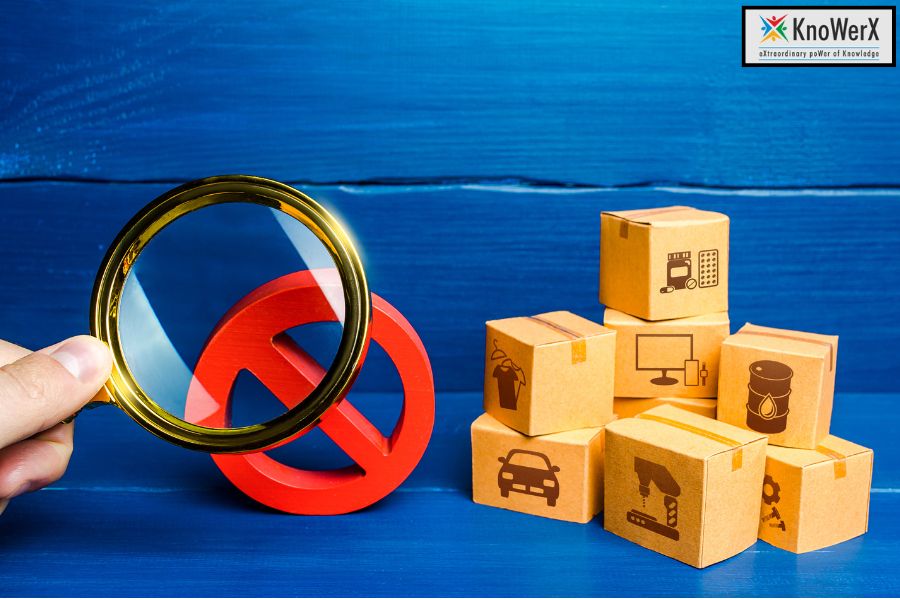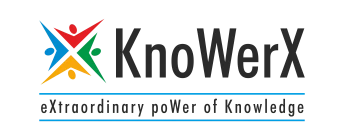Supply Chain Risk and Resiliency: Act Before Crisis Hits

Supply Chain Risk and Resiliency: Act Before Crisis Hits By KnoWerX – Your Partner in Supply Chain Management Excellence The Supply Chain Risk and Resiliency of your business is very important for its long-term success in today’s unstable world. Companies can’t just react to problems anymore; they have to act before they happen. We at KnoWerX think that training and being ready are the best ways to strengthen your supply chain. We have more than 33 years of combined experience and can help you improve your adaptability, continuity, and performance. Here are essential tips to build Supply Chain Risk and Resiliency so you’re always one step ahead: 1. Conduct End-to-End Risk Assessments Regularly Mapping and evaluating risks across the supply chain enables organisations to anticipate vulnerabilities before they escalate. From supplier performance to geopolitical issues, visibility is critical. A regular audit strengthens your Supply Chain Risk and Resiliency by identifying weak links and reinforcing strategic areas. Tip: Use data analytics tools to assess vendor reliability, market trends, and transport risks to make informed decisions. 2. Diversify Suppliers and Logistics Partners Relying on a single supplier or region can make your business highly vulnerable to disruptions. A resilient strategy involves diversifying your supplier base across multiple geographies. This enhances Supply Chain Risk and Resiliency by ensuring you have alternatives when primary channels fail. Tip: Maintain relationships with backup vendors, even if you don’t use them regularly they are your insurance during disruptions. 3. Build Real-Time Visibility Through Technology Digitisation is the foundation of a resilient supply chain. Technologies like IoT, AI, and blockchain offer real-time tracking, predictive analytics, and transparent operations. These tools directly improve your Supply Chain Risk and Resiliency by allowing swift response and intelligent planning. Tip: Invest in Supply Chain Management (SCM) platforms that provide end-to-end visibility and automate alerts for proactive actions. 4. Establish a Responsive Crisis Management Plan Even with the best preparations, disruptions may still occur. A comprehensive crisis response framework helps organisations adapt quickly and reduce downtime. Preparedness strengthens Supply Chain Risk and Resiliency by aligning teams on emergency roles, communication protocols, and recovery timelines. Tip: Conduct regular crisis simulation drills to train teams and improve response efficiency. 5. Develop a Skilled and Informed Workforce Your team is the backbone of any supply chain operation. Equip them with the latest knowledge and certifications in supply chain best practices. At KnoWerX, we empower professionals through certified programs that focus on building Supply Chain Risk and Resiliency as a core competency. Tip: Encourage continuous learning and enrol teams in KnoWerX’s specialised courses to stay ahead of evolving challenges. 6. Incorporate Sustainability and Ethical Sourcing Environmental risks, labour strikes, and regulatory non-compliance can all affect your supply chain. Incorporating sustainable and ethical practices not only strengthens your brand but also enhances Supply Chain Risk and Resiliency by reducing operational and reputational risks. Tip: Partner with suppliers who share your values for long-term collaboration and low-risk operations. 7. Monitor Global Trends and Policy Changes A global supply chain is influenced by political, economic, and environmental shifts. Staying informed about global events helps you anticipate and act proactively. This foresight significantly boosts Supply Chain Risk and Resiliency and helps you stay agile in dynamic markets. Tip: Subscribe to global trade updates and follow industry-specific bulletins to stay ahead. Frequently Asked Questions Ending Remarks Supply Chain Risk & Resiliency is more than simply a way to follow the rules; it’s also a way to go ahead of the competition. You protect your business, your reputation, and your customers’ happiness by responding before a problem happens. At KnoWerX, we are committed to helping professionals make their supply chains future-proof by offering top-notch training, certification, and consulting services. Let us help you make the most of your uncertainty. Image Reference: Freepik Disclaimer: All trademarks, logos, and brand names are the property of their respective owners. All company, product, and service names used in this website are for identification purposes only. Use of these names, trademarks, and brands does not imply endorsement.
Automated Warehousing: The Next Industrial Leap

Automated Warehousing: The Next Industrial Leap – Tips for Success The logistics and supply chain industry is undergoing a massive transformation, with Automated Warehousing leading the charge. As businesses strive for efficiency, accuracy, and cost-effectiveness, automation has become a game-changer. At KnoWerX, we understand the critical role of Automated Warehousing in modern supply chains. With over 33 years of collective experience in training and consultancy, we empower professionals to harness the power of automation for operational excellence. Here are some essential tips to help businesses and professionals 1. Understand the Core Technologies Behind Automated Warehousing Before implementing automation, it’s crucial to understand the technologies driving it: Robotic Process Automation (RPA):Robots handle repetitive tasks like picking, packing, and sorting. Automated Guided Vehicles (AGVs):Self-driving vehicles transport goods within warehouses. Warehouse Management Systems (WMS):AI-powered software optimizes inventory tracking and order fulfilment. IoT & Sensors: Real-time monitoring of stock levels, temperature, and equipment health. Investing in the right technology ensures seamless integration and maximizes ROI. 2. Start with a Phased Implementation Transitioning to Automated Warehousing doesn’t have to happen overnight. A phased approach minimizes disruptions: Pilot Testing: Begin with automating a single process (e.g., automated sorting). Evaluate Performance: Measure efficiency gains and identify bottlenecks. Scale Gradually: Expand automation to other areas based on initial success. This method reduces risk and allows for continuous improvement. 3. Optimize Warehouse Layout for Automation Traditional warehouse designs may not suit automated systems. Consider: Dynamic Storage Solutions: Use automated storage and retrieval systems (AS/RS) for vertical space utilization. Clear Pathways for AGVs: Ensure unobstructed routes to prevent delays. Zoning Strategies: Separate high-demand items for faster robotic retrieval. A well-planned layout enhances speed and reduces operational costs. 4. Focus on Workforce Training & Upskilling While Automated Warehousing reduces manual labour, human oversight remains essential. Train Employees on New Systems: Workers should understand how to operate and troubleshoot automated equipment. Develop Analytical Skills: Employees must interpret data from WMS and IoT devices. Encourage Adaptability: As technology evolves, continuous learning ensures long-term success. At KnoWerX, our Supply Chain Management Training programs equip professionals with the skills needed to thrive in automated environments. 5. Leverage Data Analytics for Continuous Improvement Automation generates vast amounts of data. Use analytics to: Predict Demand: AI-driven forecasting ensures optimal stock levels. Monitor Equipment Health: Prevent breakdowns with predictive maintenance. Enhance Order Accuracy: Reduce errors by analysing picking patterns. Data-driven decisions lead to smarter, more efficient warehouses. 6. Ensure Cybersecurity in Automated Systems With increased connectivity comes higher cyber risks. Protect your Automated Warehousing systems by: Implementing Encryption: Secure data transmission between devices. Regular Software Updates: Patch vulnerabilities in WMS and IoT networks. Access Control Measures: Restrict system access to authorized personnel only. A breach could disrupt operations and lead to significant losses. 7. Partner with Reliable Automation Vendors Choosing the right technology provider is critical. Look for vendors with: Proven Expertise: Check case studies and client testimonials. Scalable Solutions: Ensure their systems can grow with your business. Strong Support Services: Reliable maintenance and troubleshooting are a must. At KnoWerX, we collaborate with industry leaders to bring you the latest insights on Automated Warehousing solutions. 8. Measure KPIs to Track Success Key Performance Indicators (KPIs) help assess automation effectiveness: Order Accuracy Rate: Measures error reduction. Throughput Time: Tracks speed of order processing. ROI on Automation: valuates cost savings vs. investment. Regular KPI analysis ensures continuous optimization. 9. Stay Updated on Emerging Trends The Automated Warehousing landscape is evolving rapidly. Keep an eye on: AI & Machine Learning: Smarter robots that learn from operations. Blockchain for Transparency: Secure, tamper-proof supply chain records. Green Automation: Energy-efficient systems for sustainability. Staying ahead of trends ensures long-term competitiveness. 10. Invest in Professional Training & Certification To fully capitalize on Automated Warehousing, professionals need specialized knowledge. KnoWerX offers: Certified Supply Chain Professional (CSCP) Programs Warehouse Automation Specialization Courses Hands-on Training with Simulation Tools Our 26+ years of industry expertise ensure you receive top-tier education at the best price. Frequently Asked Questions Ending Remarks Automated Warehousing is undeniably the next industrial leap, revolutionizing how businesses manage inventory, fulfil orders, and optimize logistics. By following these tips, companies can transition smoothly, maximize efficiency, and gain a competitive edge. At KnoWerX, we are committed to empowering professionals with cutting-edge Supply Chain Management Training. Whether you’re looking to upskill or implement automation in your organization, we provide the knowledge and tools for success. Embrace the future of warehousing automate, innovate, and lead with KnoWerX! Image Reference: Freepik Disclaimer: All trademarks, logos, and brand names are the property of their respective owners. All company, product, and service names used in this website are for identification purposes only. Use of these names, trademarks, and brands does not imply endorsement.
What is Monitoring Capacity Buffers in Supply Chain Management?

Understanding of Monitoring Capacity Buffers in Supply Chain Management? Capacity buffers refer to the extra resources (machinery, labour, storage, or transportation) maintained to absorb unexpected fluctuations in demand or supply disruptions. These buffers act as a safety net, ensuring that operations continue smoothly even under stress. Monitoring Capacity Buffers involves: Tracking real-time resource utilization Identifying underused or overburdened assets Adjusting capacity dynamically to match demand Preventing bottlenecks before they disrupt operations Without proper Monitoring Capacity, businesses risk inefficiencies, stockouts, excess inventory, and lost revenue. Why Monitoring Capacity Buffers is Crucial for Smart SCM Prevents Bottlenecks & Enhances Operational Flow Supply chains are prone to congestion points where delays occur due to imbalanced workloads. Monitoring Capacity Buffers helps: Detect potential slowdowns in production or logistics Reallocate resources to maintain smooth operations Reduce lead times and improve order fulfilment Example: A manufacturing plant with real-time Monitoring Capacity Buffers can shift labour between production lines to prevent downtime when one machine fails. Optimizes Resource Utilization & Reduces Costs Excess capacity leads to wasted resources, while insufficient capacity causes delays. Monitoring Capacity Buffers ensures: Balanced workload distribution Minimized idle labour or machinery Lower operational costs through efficient asset use Case Study: A logistics company reduced fuel and labour costs by 15% after implementing dynamic Monitoring Capacity Buffers in its fleet management. Improves Demand-Supply Alignment Market demand fluctuates due to seasons, trends, or disruptions. Monitoring Capacity Buffers enables businesses to: Scale production up or down based on real-time demand Avoid overstocking or stockouts Maintain optimal inventory levels Example: A retail chain using AI-driven Monitoring Capacity Buffers adjusted warehouse staffing ahead of holiday sales spikes, improving efficiency by 20%. Mitigates Supply Chain Risks Unpredictable events supplier delays, natural disasters, or sudden demand surges—can cripple unprepared businesses. Monitoring Capacity Buffers helps: Identify vulnerabilities in the supply chain Build resilience with backup resources Respond swiftly to disruptions Case Study: An automotive supplier avoided a $2M loss during a port strike by rerouting shipments using real-time Monitoring Capacity Buffers data. Enhances Decision-Making with Data-Driven Insights Modern SCM relies on analytics. Monitoring Capacity Buffers provides: Real-time visibility into resource usage Predictive analytics for future capacity needs Insights for better workforce and production planning Example: A food processing company used historical Monitoring Capacity Buffers data to optimize seasonal hiring, reducing labour costs by 12%. Challenges in Monitoring Capacity Buffers While Monitoring Capacity offers immense benefits, businesses face hurdles such as: Data Accuracy & Integration Issues Siloed systems may provide inconsistent data. IoT and AI-driven tools can help unify data sources. Resistance to Change Employees may resist new monitoring systems. Training and change management are crucial. Cost of Implementation Advanced analytics tools require investment. However, long-term savings outweigh initial costs. Dynamic Demand Fluctuations Sudden market changes can strain buffers. AI-powered forecasting improves adaptability. Best Practices for Effective Monitoring Capacity Buffers Implement Real-Time Tracking Systems Use IoT sensors, ERP, and SCM software for live updates. Cloud-based platforms enable remote Monitoring Capacity. Leverage Predictive Analytics AI and machine learning forecast demand trends. Helps adjust buffers proactively. Adopt Flexible Workforce Strategies Cross-train employees for multi-skilled roles. Use temp staffing during peak demand. Collaborate with Suppliers & Partners Share capacity data for better coordination. Jointly plan buffer strategies. Continuously Review & Optimize Regularly audit buffer performance. Adjust strategies based on new data. How KnoWerX Helps You Master Smart SCM Strategies At KnoWerX, our Supply Chain Management Training programs cover: ✔ Advanced SCM techniques, including Monitoring Capacity ✔ Real-world case studies from global supply chains ✔ Hands-on tools for predictive analytics and IoT integration ✔ Certification programs to validate your expertise With 33+ years of industry experience, we’ve trained professionals from top firms like Amazon, Unilever, and DHL. Frequently Asked Questions Ending Remarks: Monitoring Capacity Buffers = Smarter Supply Chains Monitoring Capacity Buffers is no longer optional it’s a necessity for resilient, efficient, and cost-effective supply chains. By adopting real-time tracking, predictive analytics, and flexible strategies, businesses can stay agile in a volatile market. Ready to elevate your SCM skills? Enrol in KnoWerX’s Supply Chain Management Training today and gain the expertise to implement Smart SCM strategies successfully! Image Reference: Freepik Disclaimer: All trademarks, logos, and brand names are the property of their respective owners. All company, product, and service names used in this website are for identification purposes only. Use of these names, trademarks, and brands does not imply endorsement.
Outdated Supply Chain Strategy and Tactics? Time to Upgrade

Outdated Supply Chain Strategy and Tactics? Time to Upgrade! In today’s rapidly evolving global economy, relying on outdated Supply Chain Strategy and Tactics can hinder your growth and expose your business to operational risk. Traditional models built on predictability, bulk production, and static planning no longer serve the needs of a volatile, tech-driven market. At KnoWerX, we empower professionals to transition from outdated frameworks to modern, agile, and data-backed supply chain practices. If your strategy hasn’t evolved recently, it’s time to reimagine and upgrade.Abandon the One-Size-Fits-All Model Today’s dynamic markets demand flexibility. Uniform Supply Chain Strategy and Tactics are no longer effective. Consider segmented strategies tailored for different product lines, customer behaviours, or geographies. What works in Mumbai may not work in Madrid! Implement region-specific inventory and distribution models Use data to tailor fulfilment strategies for different customer segments Adjust sourcing strategies based on risk levels and delivery times Integrate Real-Time Data Analytics If you’re still making decisions based on last month’s reports, you’re lagging behind. Real-time data enables predictive modelling and faster course corrections hallmarks of modern Supply Chain Strategy and Tactics. Start leveraging AI-driven dashboards and IoT integration to stay ahead. Adopt live dashboards for inventory and logistics tracking Use predictive analytics to plan for demand surges Automate alerts to flag supply disruptions or delays instantly Don’t Just Automate Educate While automation is essential, people still make the system work. Upskill your workforce with professional certifications that align with upgraded Supply Chain Strategy and Tactics. KnoWerX offers top-tier training to empower your teams with the latest tools and thinking. Enroll your teams in KnoWerX certification programmes Encourage regular learning and cross-functional skill-building Combine automation tools with skilled human oversight Reassess Your Supplier Network Global instability has shown us the risks of over-reliance. Effective Supply Chain Strategy and Tactics now demand multi-sourcing, local alternatives, and contingency planning. Diversify your supplier base and foster collaborative partnerships, not transactional ones. Evaluate the performance and risk factor of all key suppliers Source locally to reduce lead time and build agility Establish secondary vendors for critical components Make Sustainability a Strategic Driver Environmental accountability is no longer optional. Include green logistics and circular economy principles in your Supply Chain Strategy and Tactics. This not only boosts brand image but also prepares your business for future regulations and cost efficiencies. Optimise transportation routes to lower carbon emissions Integrate reusable packaging and waste reduction initiatives Align logistics with sustainability certifications and goals Prioritise End-to-End Visibility You can’t optimise what you can’t see. Full transparency across the supply chain is essential. Modern Supply Chain Strategy and Tactics incorporate blockchain, advanced ERP systems, and cross-functional dashboards to track goods, capital, and information seamlessly. Deploy cloud-based tools for unified data access Use blockchain to ensure product traceability and trust Implement real-time tracking for shipments and inventory Build for Agility, Not Just Efficiency The old race was about cutting costs. The new race is about responding to disruption. Your Supply Chain Strategy and Tactics must now be agile capable of adapting to everything from natural disasters to sudden demand shifts. Use modular systems that allow fast changes in operations Include buffer stock or flexible manufacturing in planning Train teams to adapt processes during unexpected events Invest in Scenario Planning What if your biggest supplier shuts down? What if fuel prices spike? Outdated Supply Chain Strategy and Tactics don’t ask “what if.” Build scenario planning into your operating model to anticipate change rather than react to it. Simulate worst-case supply chain scenarios quarterly Maintain a contingency playbook for common disruptions Use digital twins to model and test alternatives Think Beyond Logistics A truly modern Supply Chain Strategy and Tactics mindset involves collaboration between finance, marketing, and operations. Encourage interdepartmental sync-ups and create shared KPIs to foster a unified strategic direction. Align budgeting and procurement with supply chain goals Involve marketing in forecasting and promotion alignment Set shared KPIs to unite different departments under one vision Frequently Asked Questions Ending Notes Upgrading your Supply Chain Strategy and Tactics isn’t just about keeping up it’s about leading from the front. Businesses that embrace change, technology, and training will outperform those that cling to outdated models. At KnoWerX, we bring over 33 years of expertise in education and consultancy, having worked with top companies in India and internationally. Whether you’re looking to enhance your personal skill set or transform your organisation’s supply chain capabilities, KnoWerX is your trusted partner in this journey. Invest in smarter strategies today because the future doesn’t wait. Image Reference: Freepik Disclaimer: All trademarks, logos, and brand names are the property of their respective owners. All company, product, and service names used in this website are for identification purposes only. Use of these names, trademarks, and brands does not imply endorsement.
What are the top 5 pillars of supply chain management

What are the top 5 pillars of supply chain management Supply chain management (SCM) is the backbone of any successful business, ensuring seamless operations from procurement to delivery. At KnoWerX, with over 33 years of collective expertise in training and consultancy, we empower professionals to master SCM best practices. Whether you’re an aspiring professional or an industry veteran, understanding these five critical pillars will help you optimize efficiency, reduce costs, and drive business growth. Here are the top 5 pillars of supply chain management that every professional should focus on: 1. Strategic Planning & Forecasting Tip: Leverage data analytics for demand forecasting to minimize excess inventory and stockouts. Effective supply chain management begins with strategic planning and forecasting. Businesses must analyze historical data, market trends, and consumer behavior to predict demand accurately. Advanced tools like AI and machine learning can enhance forecasting precision, reducing waste and improving inventory turnover. Companies that master this pillar avoid overstocking while ensuring product availability, leading to better customer satisfaction and cost savings. 2. Efficient Procurement & Supplier Relationships Tip: Build strong supplier partnerships for reliability and cost-effectiveness. Procurement is more than just purchasing it’s about building strategic supplier relationships. A well-managed supply chain depends on reliable vendors who deliver quality materials on time. Implementing supplier performance metrics, negotiating favorable contracts, and diversifying suppliers can mitigate risks. Strong partnerships also enable bulk purchasing discounts and long-term stability, making procurement a key driver of supply chain efficiency. 3. Seamless Logistics & Distribution Tip: Optimize transportation routes to cut costs and enhance delivery speed. Logistics is the lifeline of supply chain management, ensuring products move efficiently from warehouses to consumers. Companies should invest in route optimization software and real-time tracking to minimize delays and fuel costs. Multi-modal logistics (combining road, rail, air, and sea transport) can enhance flexibility, especially in global supply chains. Efficient logistics not only reduces operational expenses but also improves customer satisfaction through faster, more reliable deliveries. 4. Warehouse & Inventory Management Tip: Automate inventory tracking to reduce human errors and improve accuracy. A well-organized warehouse is crucial for smooth supply chain operations. Implementing Warehouse Management Systems (WMS) and automation (like RFID and barcode scanning) ensures real-time inventory visibility. Techniques like Just-in-Time (JIT) inventory minimize storage costs while preventing stockouts. Proper warehouse layout and automated replenishment systems further enhance efficiency, making inventory management a cornerstone of successful SCM. 5. Risk Management & Continuous Improvement Tip: Develop contingency plans to handle disruptions like delays or shortages. Supply chains face risks—natural disasters, geopolitical issues, supplier failures—that can disrupt operations. Proactive risk management involves identifying vulnerabilities and creating backup plans. Additionally, adopting Lean and Six Sigma methodologies helps eliminate inefficiencies and streamline processes. Continuous improvement through regular audits and feedback loops ensures long-term resilience and competitiveness in supply chain management. Why Choose KnoWerX for Supply Chain Management Training? Industry-Leading Expertise:26+ years in SCM training & consultancy. Practical Learning:Real-world case studies and hands-on training. Affordable Excellence:High-quality education at competitive prices. Frequently Asked Questions Ending Notes Effective supply chain management is no longer optional, it’s a competitive necessity. By focusing on these five critical pillars including strategic planning, procurement, logistics, inventory management, and risk mitigation, you can build a resilient, efficient, and cost-effective supply chain that drives business growth. Whether you’re looking to optimize operations, reduce costs, or future-proof your supply chain, mastering these pillars will set you apart in today’s dynamic business landscape. Ready to take your supply chain expertise to the next level? Contact KnoWerX today and unlock your potential Image Reference: Freepik Disclaimer: All trademarks, logos, and brand names are the property of their respective owners. All company, product, and service names used in this website are for identification purposes only. Use of these names, trademarks, and brands does not imply endorsement.
Common Six Sigma Inferential Statistics Errors

Common Six Sigma Inferential Statistics Error Making data-driven judgements is more crucial than ever in the cutthroat corporate climate of today. Six Sigma approaches depend mostly on Six Sigma Inferential Statistics to examine data, streamline operations, and strengthen quality control. Many experts, meantime, run into typical statistical mistakes that could result in false findings and lost chances for development. At KnoWerX, a leader in Supply Chain Management training with over three decades of experience, we recognize the challenges professionals face when applying inferential statistics in real-world scenarios. Equipping you with useful ideas and advice to prevent these traps helps you to have more precise analyses and improved decision-making results. Assuming Your Data is Normally Distributed Is Wrong Many Six Sigma practitioners mistakenly believe data is normally distributed and go directly to parametric tests. Six Sigma Inferential Statistics, on the other hand, calls for data dispersion checks prior to any analysis. Confirm distribution using methods include histograms, box plots, or normality tests such as Anderson-Darling. Ignoring this stage could lead to erroneous conclusions and unsuitable tests. Grasp the Strength of Sample Size Selecting the appropriate sample size is not only a numbers game; it affects the dependability of your study directly. A mistake here could cause either low statistical power or waste of resources. Power analysis in Six Sigma Inferential Statistics guarantees you gather just the correct quantity of data to identify genuine effects without stressing the process. It’s about equilibrium, not mass. Stay Away from P-value Blindness A lower p-value could thrill you, but don’t allow it blind you to pragmatic reality. A statistically significant outcome does not automatically imply a major corporate shift. To guarantee the outcome has real-world applicability, combine your p-values with confidence intervals and effect sizes in Six Sigma Inferential Statistics. Decision-making should fit business strategy as well as data. Confusing Causation with Correlation One can be tempted to read a correlation in data as causality; but, this is false. Causality cannot be verified without controlled experiments. Using regression, root cause analysis, and Design of Experiments (DOE), Six Sigma Inferential Statistics promotes deeper investigation. Don’t rush to conclusions; investigate the data’s “why”. Ignoring Hypothesis Testing Assumptions Every statistical test has assumptions normality, independence, equal variance that must be checked. Ignoring these criteria could result in utterly erroneous research. Testing requirements is disciplined by Six Sigma Inferential Statistics. Before making conclusions, make sure your data satisfies the model’s criteria using techniques such scatter plots, Levene’s test, and residual plots. Misunderstanding Confidence Intervals Many times, confidence intervals are confused with probability ranges. Based on the sample data, they really provide a range within which the actual parameter is likely to fall. Knowing confidence intervals in Six Sigma Inferential Statistics lets you evaluate result stability and measure uncertainty. It’s about statistical certainty and decision assurance, not guessing. Ignoring Measurement System Errors Your measurement system determines the quality of your statistical findings. Inconsistent instruments or operators lead to unreliable data. Data correctness in Six Sigma Inferential Statistics is guaranteed by doing a correct Measurement System Analysis (MSA). Ignoring this stage results in faulty inputs and therefore subpar results. Frequently Asked Questions Ending Notes At KnoWerX, we create professionals not only by teaching theory. Drawing on more than 33 years of combined experience and 26+ years in worldwide consulting and training, we provide practical insights that help professionals succeed. Designed for people wishing to grasp Six Sigma Inferential Statistics, our certifications and learning modules help to raise their professions by means of data mastery, accuracy, and strategic thinking. Image Reference: Freepik Disclaimer: All trademarks, logos, and brand names are the property of their respective owners. All company, product, and service names used in this website are for identification purposes only. Use of these names, trademarks, and brands does not imply endorsement.
Why Top Firms Invest Heavily in Material Handling?

Why Top Firms Invest Heavily in Material Handling? Efficient supply chain management relies on effective material handling, which top companies recognize as crucial for boosting production, cutting costs, and achieving market leadership. With over 33 years of combined expertise in supply chain training and consulting, KnoWerX empowers professionals to excel through industry-leading education programs. These vital insights explain why major corporations invest heavily in optimizing their operations: it streamlines workflows, enhances efficiency, and solidifies their competitive edge in dynamic markets. Maximise operational efficiency Efficient material handling increases production, reduces delays, and simplifies processes. Advanced technologies, such as automated conveyors or robotics, minimise manual chores, ensuring quicker product transportation. This optimisation improves general operating effectiveness by enabling companies to precisely manage more volume. Furthermore, streamlined workflows reduce operational costs and enhance workplace safety, boosting overall productivity. Automate to lower expenses Leading companies leverage material handling systems to save labor expenses and reduce errors. Automated solutions, such as warehouse management systems, optimize inventory and minimize waste, delivering significant cost savings. These technologies also lower long-term operating costs, boosting profitability. By integrating advanced automation, businesses enhance efficiency and streamline operations, further improving their bottom line. Improve Safety at Work Purchasing ergonomic lifting tools and other equipment enhances workplace safety by reducing occupational injuries. Safe techniques ensure regulatory compliance, minimize liability risks, and protect workers. This focus on safety fosters a positive workplace, boosts staff happiness, and improves overall productivity. Prioritizing these practices also strengthens organizational reputation and employee retention. Increase Client Satisfaction Timely order fulfilment and correct deliveries are guaranteed by means of efficient material handling. Strong material handling systems guarantee client satisfaction by reducing mistakes and delays. This consistency builds client confidence and encourages repeat business by strengthening trust. Maintain Competitiveness with Scalability Modern material handling systems provide scalability to fit market needs. Flexible systems let companies effortlessly control peak seasons or unexpected expansion. This adaptability ensures seamless operations and cost efficiency. This flexibility guarantees continuous competitiveness in changing markets. Smart Material Handling for Sustainability Leading companies put money into environmentally friendly material handling, such as reusable packaging and energy-efficient machinery. Sustainable material management complements corporate social responsibility objectives and lowers environmental effect. These policies improve brand image by appealing to eco conscious customers. Decisions Based on Data Advanced material handling systems integrate IoT and analytics to deliver real-time operational insights. Companies leverage this data to predict maintenance needs and optimize processes. These insights drive strategic decisions, enhancing supply chain efficiency. By harnessing predictive analytics, businesses can proactively address potential disruptions, further streamlining operations and boosting overall performance. Frequently Asked Questions Ending Notes Our professional training courses at KnoWerX empower you to master material handling techniques. With over 26 years of teaching and consulting experience, we’ve enabled professionals worldwide to excel in supply chain management. Join us to gain in-depth domain knowledge, earn valuable certifications, and elevate your material handling career! Our hands-on programs deliver practical skills and industry insights to keep you ahead in this dynamic field. Enroll today and transform your professional journey with KnoWerX! Benefit from our expert instructors and tailored curriculum, designed to meet the evolving demands of the supply chain industry. Take the next step toward becoming a leader in material handling excellence! Image Reference: Freepik Disclaimer: All trademarks, logos, and brand names are the property of their respective owners. All company, product, and service names used in this website are for identification purposes only. Use of these names, trademarks, and brands does not imply endorsement.
Profit from Trash? Know How to Incorporate Reverse Logistics

Profit from Trash? Know How to Incorporate Reverse Logistics Companies are coming to see reverse logistics more and more as a way to convert waste into profit in the ever-changing supply chain environment of today. With more than 33 years of combined experience, KnoWerX, a pioneer in Supply Chain Management Training, helps professionals to understand techniques such reverse logistics for sustainable success. The following useful advice will enable you to include reverse logistics into your operations, hence promoting environmental responsibility, cost reductions, and efficiency. 1. Understand the Scope of Reverse Logistics To effectively incorporate reverse logistics, start by defining its scope within your organization. Reverse logistics involves managing the return, reuse, recycling, or disposal of products after their initial sale. Assess your product lifecycle to identify opportunities for returns, refurbishment, or recycling. This foundational step ensures you create a streamlined process that maximizes value recovery. 2. Design a Customer-Centric Returns Process A seamless returns process is key to customer satisfaction and operational efficiency. Incorporate reverse logistics by implementing clear return policies, user-friendly return portals, and efficient collection mechanisms. Train your team to handle returns swiftly, ensuring products are inspected and redirected for resale, refurbishment, or recycling, minimizing losses. 3. Leverage Technology for Tracking and Transparency Technology is a game-changer when you incorporate reverse logistics. Use advanced tracking systems, such as RFID or barcode scanning, to monitor returned goods throughout the supply chain. Implement software solutions to analyze return data, identify patterns, and optimize processes. KnoWerX’s training programs emphasize leveraging such tools to enhance visibility and decision-making. 4. Optimize Inventory Management for Returned Goods Returned products can clog inventory if not managed properly. Incorporate reverse logistics by categorizing returns based on their condition resalable, refurbishable, or recyclable. Integrate these items back into your inventory or redirect them to secondary markets. Effective inventory management reduces waste and unlocks hidden revenue streams. 5. Partner with Recycling and Refurbishment Experts Collaborating with specialized partners can amplify your efforts to incorporate reverse logistics. Work with recycling firms, refurbishment centers, or third-party logistics providers to handle end-of-life products. These partnerships ensure compliance with environmental regulations and enhance your ability to recover value from discarded goods. 6. Educate Your Team on Reverse Logistics Best Practices A well-trained team is critical to successfully incorporate reverse logistics. Equip your staff with the knowledge to manage returns, assess product conditions, and execute sustainable practices. KnoWerX offers professional training programs that cover reverse logistics in-depth, empowering your team to drive profitability through efficient processes. 7. Measure and Improve Performance To ensure long-term success, incorporate reverse logistics by establishing key performance indicators (KPIs) such as return rates, recovery rates, and cost savings. Regularly analyze these metrics to identify areas for improvement. Continuous evaluation allows you to refine your reverse logistics strategy, aligning it with business goals. Frequently Asked Questions Ending Notes At KnoWerX, our 26+ years in education and consultancy enable us to deliver high-quality, practical training tailored to your needs. Our programs help professionals master how to incorporate reverse logistics, transforming waste into profit while fostering sustainability. With a commitment to excellence and affordability, KnoWerX is your trusted partner for supply chain success. By implementing these tips, you can incorporate reverse logistics to not only reduce waste but also unlock new revenue streams, proving that trash can indeed be turned into treasure. Enroll in KnoWerX’s Supply Chain Management Training today to gain the expertise needed to excel in this transformative field! Image Reference: Freepik Disclaimer: All trademarks, logos, and brand names are the property of their respective owners. All company, product, and service names used in this website are for identification purposes only. Use of these names, trademarks, and brands does not imply endorsement.
Why a Supply Chain Career is Your Best Bet

Why a Supply Chain Career is Your Best Bet A career in supply chain management opens doorways, stability, and influence in the fast-evolving, interrelated world of today. With more than 33 years of combined knowledge in Supply Chain Management Training, KnoWerX empowers people to succeed by means of best-quality education and credentials. These are our greatest suggestions to grasp why a Career in Supply Chain Management is your best option right now and how KnoWerX can lead you to success. High Industry-Wide Demand Retail, manufacturing, healthcare, and e-commerce among others depend on strong supply chains. Technological developments and globalisation have pushed businesses to aggressively look for competent people to maximise operations, reduce expenses, and guarantee efficiency. From logistics coordinators to supply chain analysts, a career in supply chain management presents varied responsibilities with reasonable pay and development prospects. KnoWerX’s training gives you the knowledge to satisfy this need. Economic Change Resilience Even in times of economic uncertainty, supply chain experts are absolutely essential. The COVID-19 epidemic highlighted the vital need of supply chains in maintaining the flow of products and services. A career in supply chain management places you in a recession-resistant sector where your abilities are constantly sought. KnoWerX’s initiatives guarantee your readiness for any financial scene. Imaginative Possibilities Supply chain processes are being transformed by technologies like artificial intelligence, blockchain, and IoT. A Supply Chain Career puts you at the forefront of innovation, allowing you to use modern ideas to simplify procedures and improve sustainability. KnoWerX’s training courses equip you with the knowledge to use these tools efficiently, helping you stay ahead in this tech-driven sector. Worldwide Job Opportunities Inherently worldwide, supply networks link people, manufacturers, and customers all across borders. A career in supply chain management lets you collaborate with multinational companies or move overseas, opening doors to worldwide possibilities. KnoWerX’s internationally known certificates provide you an advantage in the worldwide employment market. Employers all around trust our credentials. Different Skill Development A Supply Chain Career hones a wide spectrum of abilities including problem-solving, strategic thinking, data analysis, and leadership. From negotiating with suppliers to inventory optimisation, you will acquire flexible knowledge applicable across sectors. KnoWerX’s professional training guarantees you master these abilities through practical, industry-relevant education. Our courses aim to create well-rounded peopl Good Salary and Growth With entry-level jobs offering strong starting pay and top roles like Supply Chain Managers earning excellent salaries, a Supply Chain Career provides appealing compensation. Pursuing a Supply Chain Career offers rapid professional growth as companies prioritize efficiency. KnoWerX’s certificates enhance your qualifications, positioning you as a top contender for leadership roles and promotions. Our training empowers you to maximize your earning potential in a Supply Chain Career. Make a Genuine Difference Your efforts in supply chain management immediately affect a company’s performance and client happiness. You help to significant results by means of timely deliveries and environmental impact reduction. KnoWerX’s training stresses excellent practices so you may promote good transformation in your company. Your work creates a better future for companies and communities. Frequently Asked Questions Ending Notes KnoWerX, your reliable partner in developing a successful Career in Supply Chain Management, with 26+ years in teaching and consulting. Designed by professionals who have trained and advised for leading firms in India and internationally, our expert-led programs provide high-quality, affordable education. We offer the tools, credentials, and subject expertise required to succeed in this expanding sector. Begin your path with KnoWerX now to discover the limitless potential of a Career in Supply Chain Management! Image Reference: Freepik Disclaimer: All trademarks, logos, and brand names are the property of their respective owners. All company, product, and service names used in this website are for identification purposes only. Use of these names, trademarks, and brands does not imply endorsement.
Don’t Let Examples of Demand Forecasting Fail!

Don’t Let Examples of Demand Forecasting Fail! Here are some mind-blowing tips on Examples of Demand Forecasting from KnoWerX, your trusted industry leader in Supply Chain Management Training. Through our Professional Training programs and high-quality education, we empower professionals to achieve success and excellence. With over 33 years of collective experience and 26+ years in education and consultancy, our experts have guided major companies in India and abroad to build their expertise. We are committed to delivering the best quality education at the most competitive prices, making KnoWerX your one-stop destination for learning best practices, acquiring domain knowledge, and earning relevant certifications. Leverage Historical Data for Predictive Power One of the most astonishing Examples of Demand Forecasting is using historical sales data with advanced analytics. At KnoWerX, we teach professionals to analyze past trends to predict future demand with uncanny accuracy, helping businesses stay ahead of market shifts. This approach also minimizes overstocking and enhances profitability with precise inventory control. Harness AI and Machine Learning Innovations An eye-opening Example of Demand Forecasting is the use of AI-driven tools. Our training programs at KnoWerX guide you to implement machine learning models that adapt to real-time data, revolutionizing inventory planning like never before. This technology also identifies subtle patterns that human analysis might miss, boosting forecast reliability. Simulate Seasonal Demand Spikes A surprising Example of Demand Forecasting involves simulating seasonal trends. KnoWerX experts train you to create scenarios that predict holiday surges or off-season dips, ensuring your supply chain remains resilient and profitable. This method also allows for proactive resource allocation, keeping your operations smooth year-round. Integrate Point-of-Sale Data for Real-Time Insights One of the most impressive Examples of Demand Forecasting is integrating POS data. Through KnoWerX’s high-quality education, learn to use real-time sales inputs to adjust forecasts instantly, keeping your business agile and responsive. This technique also reduces waste by aligning stock levels with actual consumer behavior. Collaborate with Suppliers for Holistic Forecasts A game-changing Example of Demand Forecasting is collaborating with suppliers. At KnoWerX, we emphasize building partnerships to share data, creating forecasts that align the entire supply chain for maximum efficiency. This collaboration also fosters innovation, as joint insights lead to better product offerings and market strategies. Use Weather Patterns to Anticipate Demand An unexpected Example of Demand Forecasting is factoring in weather data. Our Professional Training at KnoWerX equips you to predict demand for seasonal products like umbrellas or heaters, giving your business a competitive edge. This approach also helps in planning marketing campaigns tailored to weather-driven consumer needs. Apply Scenario Planning for Uncertainty A brilliant Example of Demand Forecasting is scenario planning for unpredictable events. KnoWerX’s expert-led programs teach you to prepare multiple demand scenarios, safeguarding your operations against disruptions. This strategy also builds confidence among stakeholders by showcasing preparedness for any market condition. Frequently Asked Questions Ending Remarks Mastering the Examples of Demand Forecasting can revolutionize your supply chain strategy and drive business success. At KnoWerX, with our 33+ years of expertise and 26+ years in education and consultancy, we empower professionals with top-tier training and certifications at competitive prices. Whether you leverage AI, historical data, or supplier collaboration, our programs equip you to turn forecasts into actionable insights. Join KnoWerX today and elevate your career while building a resilient, profitable future! Image Reference: Freepik Disclaimer: All trademarks, logos, and brand names are the property of their respective owners. All company, product, and service names used in this website are for identification purposes only. Use of these names, trademarks, and brands does not imply endorsement.
